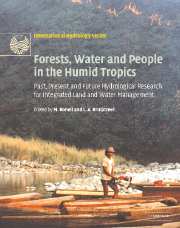 Forests, Water and People in the Humid Tropics
Forests, Water and People in the Humid Tropics Book contents
- Frontmatter
- Contents
- List of contributors
- Foreword
- Preface
- Acknowledgements
- Symposium and Workshop
- Introduction
- Part I Current trends and perspectives on people–land use–water issues
- Part II Hydrological processes in undisturbed forests
- Part III Forest disturbance, conversion and recovery
- Part IV New methods for evaluating effects of land-use change
- 27 Remote sensing tools in tropical forest hydrology: new sensors
- 28 Detecting change in river flow series
- 29 How to choose an appropriate catchment model
- 30 The disaggregation of monthly streamflow for ungauged sub-catchments of a gauged irrigated catchment in northern Thailand
- 31 Parsimonious spatial representation of tropical soils within dynamic rainfall—runoff models
- 32 Isotope tracers in catchment hydrology in the humid tropics
- 33 Process-based erosion modelling: promises and progress
- 34 Impacts of forest conversion on the ecology of streams in the humid tropics
- Part V Critical appraisals of best management practices
- Conclusion: Forests, water and people in the humid tropics: an emerging view
- Plate section
- References
28 - Detecting change in river flow series
from Part IV - New methods for evaluating effects of land-use change
Published online by Cambridge University Press: 12 January 2010
- Frontmatter
- Contents
- List of contributors
- Foreword
- Preface
- Acknowledgements
- Symposium and Workshop
- Introduction
- Part I Current trends and perspectives on people–land use–water issues
- Part II Hydrological processes in undisturbed forests
- Part III Forest disturbance, conversion and recovery
- Part IV New methods for evaluating effects of land-use change
- 27 Remote sensing tools in tropical forest hydrology: new sensors
- 28 Detecting change in river flow series
- 29 How to choose an appropriate catchment model
- 30 The disaggregation of monthly streamflow for ungauged sub-catchments of a gauged irrigated catchment in northern Thailand
- 31 Parsimonious spatial representation of tropical soils within dynamic rainfall—runoff models
- 32 Isotope tracers in catchment hydrology in the humid tropics
- 33 Process-based erosion modelling: promises and progress
- 34 Impacts of forest conversion on the ecology of streams in the humid tropics
- Part V Critical appraisals of best management practices
- Conclusion: Forests, water and people in the humid tropics: an emerging view
- Plate section
- References
Summary
INTRODUCTION
Detection of trends in long time series of hydrological data is of paramount scientific and practical importance. Water resources systems are typically designed and operated based on the assumption of stationary hydrology (in particular, an assumption of stationarity of the stochastic proces of river stage or discharge). If this assumption is incorrect then existing procedures for example in the design of levees, dams and reservoirs will have to be revised. Without revision, the systems can be over- or underdesigned and either not serve their purpose adequately or be overly costly.
Studies of change are also of importance because of our need to understand the impact that man is having on the ‘natural’ world. Changes caused directly by man (deforestation, land-use changes, changes in agricultural practices, drainage systems, dam construction, water abstraction, river regulation, urbanisation, etc.) or indirectly via emissions of greenhouse gases, are just a few examples of anthropogenic activities that may be altering important aspects of the hydrological cycle. In addition, natural catchment changes, such as to the channel morphology, can also occur.
The search for climate change signatures in hydrological data has been of much interest recently, driven by the possibility of climate change causing more frequent and severe floods in the future. There are several non-climate mechanisms which may contribute to this effect. Some of them relate to the anthropogenic pressures such as reduction in water resources storage capacity, acceleration of flow in water courses, plus those arising from increasing populations and wealth accumulated in endangered areas.
- Type
- Chapter
- Information
- Forests, Water and People in the Humid TropicsPast, Present and Future Hydrological Research for Integrated Land and Water Management, pp. 703 - 716Publisher: Cambridge University PressPrint publication year: 2005
References
- 2
- Cited by


